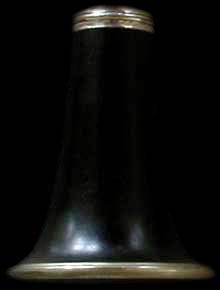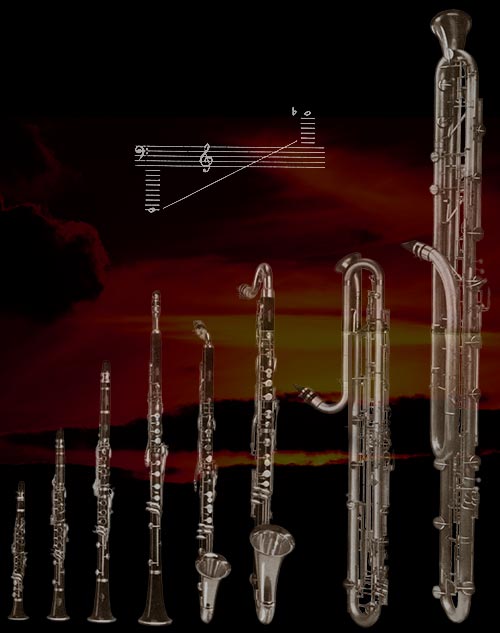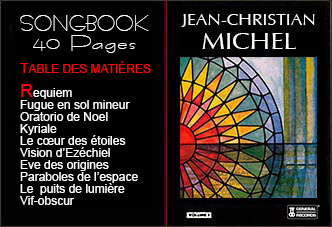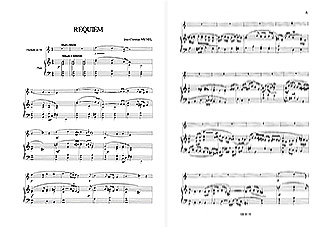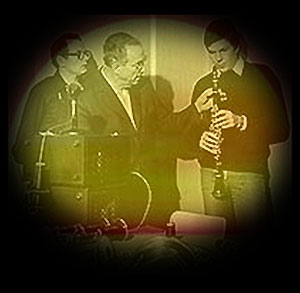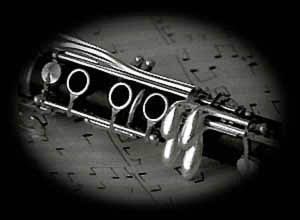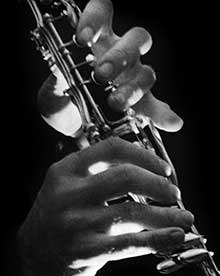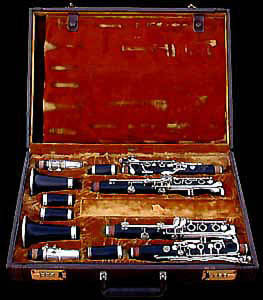Clarinet comes from the Latin clarus "light". It is an instrument relatively unknown to the public. Nevertheless, with its register of more than three octaves and its exceptional ability to communicate the most subtle nuances of human breath, it astounds through the beauty of its timbre and its expressive force. Could it be that one day it will be quoted among the most beautiful instruments of the world ? The clarinet, of the woodwind family of instruments, consists of 4 hollow pieces of ebony - the upper and lower joints, a barrel and a bell - which fit together to make up a beautiful assemblage. A ligature holds a simple reed to the mouthpiece. Below the upper body, an indispensable key allows access to the twelve lowest notes, thus enlarging considerably the range of the instrument.
THE ANCESTORS OF THE CLARINET AND THE CHALUMEAU Well before Christian era, in ancient Egypt, Greece, and India, wind instruments, with reeds and holes already existed. It is these that will one day develop into the clarinet. To whom should we attribute the invention of the clarinet? In fact, the archaic instruments of the antiquity were gradually perfected, evolving in stages throughout the centuries. From the middle ages in Europe the chalumeau was used in pastoral music. It was a rudimentary instrument without a bell and only 8 or 9 holes and with a register barely exceeding one octave. The reed, built into a small tube, was not in contact with the lips - the musician blew through a sort of pipe - which emitted a sound without much soul or character. The chalumeau is nevertheless the origin of the entire woodwind family. THE CLARINET FROM DENNER TO TODAY At the beginning of 18th century, German instrument maker DENNER replaced the tube by a mouthpiece, with a ligatured reed. He shaped a cylindrical body and a bell. He added the famous "twelfth hole" with its two corresponding keys... The clarino - which really prefigured the clarinet - had been born, with henceforth three registers : the upper, the medium and the clarion.
Various innovations were to take place in the next two centuries. In 1812 Müller perfected the instrument and produced a clarinet with 13 keys. This new creation greatly eased the task of clarinettists and brought a renewal of interest in the clarinet. THE CLARINET ADAPT THE BOEHM SYSTEM
In 1844, KLOSÉ, a clarinet professor at the Conservatoire of PARIS and concert performer, particularly well-known to young clarinettists for his Method, adapted the BOEHM system of mobile rings used on the flute to the clarinet. He also added the barrel, to refine the accuracy of the instrument, and created - very nearly - the modern clarinet. The clarinet is a transposed instrument : the "la" of the clarinet does not correspond to the "la" of the piano. Clarinets of various lengths and timbres appear according to the needs of the orchestra. THE CLARINET FAMILY : THE 12 VARIOUS SORTS OF CLARINETS
In fact the clarinet family covers almost the entire orchestral range. The most common clarinet is the B flat. The family from bass to treble classifies as follows :
THE CLARINET IN THE DIFFERENTS MUSICAL STYLES
THE CLARINET FOR THE COMPOSERS OF CLASSICAL MUSIC : CLASSICAL CLARINET Numerous Classical music composers quickly became interested in the new timbre of the clarinet. As early as 1716 Vivaldi used it to replace the oboe, then, to quote but a few: RAMEAU, then WEBER, SPOHR, YOST ( These last three composers sacrificing depth to volubility ), BEETHOVEN then LISZT, SCHUMANN, STRAUSS, BERG, MENDELSSOHN, DEBUSSY, MASSENET, STRAVINSKY ( superb in his Rite of Spring ), DEBUSSY, D'INDY, SAINT-SAENS use it in their compositions.
The true masterpieces for clarinet are those of MOZART. His Quintet in A, his extremely beautiful Concerto in A maj, his Trio in E flat not to mention the Enchanted Flute and his Adagio for two clarinets and basset horn, all attract unlimited admiration. His masterpiece, although unfinished, is doubtless his Requiem ( which shows his love of the Clarinet Bassett Horn ). At this level of music, MOZART employs the clarinet with an incredible joy and takes emotion in the limits of purity and depth. THE CLARINET FOR JAZZ MUSICIANS : JAZZ CLARINET
The clarinet has been a part of Jazz bands since the beginning of 20th century. It may be argued that the clarinet in Jazz lacks the magnificence that it achieves in MOZART's compositions, but we can still love it as a different but very beautiful instrument. Let's allow ourselves a little departure : Jazz is anything but boring : it is created on the instant, but does not die with it. It is only necessary to agree to open the spirit, to release the somewhat fixed forms of Classical music, in brief to open another point of view. Who indeed can boast of really loving Music without being moved by BACH and MOZART, but also without enjoying the distinctive playing of Louis ARMSTRONG ? The sound's work, absent in the traditional Classical technique, opens a new musical universe extremely rich in expression and emotion. The syncopated and extremely imaginative phrasing contributes to the beat and to the life of the piece, and when the clarinet appears and embroiders the counterpoint, it is poignant and vertiginous, pulling us towards an admirable light... We remember the names of Johnny DOODS, impressing as much by his coolness as by his emotional force, Sidney BECHET, operatic and powerful, Mezz MEZZROW, Barney BIGARD, Jimmy NOONE, Albert NICHOLAS... THE CLARINET FOR JAZZ-CLASSICAL CROSSOVER MUSICIANS - JEAN-CHRISTIAN MICHEL. Jean-Christian Michel, clarinetist, naturally composes mainly for his own instrument, the clarinet. He already has more than a hundred works in his repertoire. The themes and varied clarinet pieces, the organ récitals, the luxurious returning chords arouse emotions whose depth always amazes.
In his interpretation, Jean-Christian Michel offers a new clarinet sound, between Classical and Jazz. Like Jazz musicians, he uses a phrasing and an extreme expressiveness which open the way to a world of continually renewed surprises. Among Jean-Christian Michel's works, the magnificent Concerto of Port Maria is absolutely unmissable and also his original pieces for organ, clarinet, synthesizers, bass and drums, such his "Vision d'Ezéchiel", "Ève des Origines" or "Les Paraboles de l'Espace"…and also Aranjuez's concerto ! SOME ESSENTIAL LISTENING FOR THE CLARINET ON CD
CLASSICAL MUSIC - JAZZ - JAZZ CLASSICAL CROSSOVER - SPATIAL JAZZ & SACRED MUSIC CROSSOVER
TRANSCRIPTIONS AND ARRANGEMENTS FOR CLARINET / CLASSICAL MUSIC SCORES FOR PIANO : FROM J.-S. Bach, MOZART... You want to download: indifferently use Explorer, Chrome or Firefox. You want to listen only: use Explorer or Firefox, Google does not work for listening only. Listening with Windows Media Player : Click on the link. Downloading : Click on the link / Windows media : Download as [...] / Download it !
A clarinet "factory" is simultaneously, curiously imprinted by modernism and by a tradition of craftsmanship.
A block of ebony, initially rough-hewed, is to be turned into a clarinet. After turning on a lathe and drilling, it is stored and dried for a year. Then the wood is cut to in its definitive dimensions and ollowed with the holes being drilled.
After a damp-proofing treatment by pressurised linseed oil, imperfections are sealed with resin. The internal bore of the clarinet is carefully finalised: this work is carried out with chisels, gouges and other computer-controlled sizing instruments. Usually the wood is then stained (to hide any imperfections of the wood), or left natural which is more stylish, (the ebony being not absolutely black, but of a deep brown colour). The métal pieces of the clarinet, made of nickel silver, are assembled by silver-welding. Balls, keys and springs are fitted manually. Then the pre-set keys are silvered plated, polished and re-attached. Pads (at present made of Goretex) are stuck on using wax. Cork seals and felts are the last to be fixed. After final checks, the clarinet is ready to be tried out... Today, the workmanship of the clarinet continues to evolve, in several different ways. For example, research continues to improve the accuracy of its tuning. The implementation of additional rods aims to protect certain plugs from condensation and to improve the corking and the quality of the sound. Finally, synthesized materials based on powdered ebony, carbon fibre and resin; allow the construction of bodies ( such as the Green series - Buffet-Crampon line ) which are not prone to splitting. INTERPRETATION ON THE CLARINET
Learning is one of the greatest joys in the life, and particularly in the musical art. Indeed contrary to that which one studies in certain disciplines ( where the spirit burdens itself with superfluous details ) everything is useful in the music. On the technical side, mastering the clarinet demands years and years of work and effort : it is necessary to learn to breathe, to control the breath, to work continually on the dexterity of the fingers in order to obtain the total control of the sound and to acquire the freedom of automatism. The clarinetist will try to obtain his own tone, round, warm, imprinted by sensibility, and, if possible,original. The artist will then be able to begin "playing music". Because it is not enough to align notes in a technically perfect fashion to make music : it is necessary to transcend this stage and, in the most magnificent liberty, to use technique to sensitively express feelings.Having analysed the global spirit of the piece, the artist will attempt to express their imagination in sound with all the fibres of their personality. By suggesting a note in the breath or on the contrary by stressing it to highlight it, by speeding up or slowing down imperceptibly a phrase, they will learn ow to give magnetism and colour to the musical phrase and instil his own magic. The chain of notes will then merge in the universal harmony and will then be able to generate this poetry that we call Music.Naturally then, all the greatest joys are available to one that knows how to play Music ! A "true" Music get across to the audience and its emotion always touches the public... FAMOUS CLARINETTISTS AND THE CLARINETTIST
The clarinetist is an instrumentalist who plays the clarinet. But what distinguishes him from the other musicians ? - The clarinetist is often represented as a tall and rangy being, in the same way as the bassist appears somehow to be a more massive, fatter person. Maybe, by analogy with the range of instruments... But, joking aside, there is no rule in this field !-As we saw it before, the clarinet is a transposed instrument and consequently the clarinetist will be always called upon to transpose ( except if he uses the small clarinet in C ). The majority of the clarinettists who use the clarinet in B flat are not worried by transposing from C to B flat, because hey have long experience of it. - In the Classical orchestra, the clarinet appears next to flutes, oboe and bassoons. The sound of Classical clarinet must be played pure and straight, according to the rules of the conservatoire. The clarinetist is widely appreciated as a soloist and if it was necessary to verify that, you could listen day and night to the MOZART's sublime "Concerto for clarinet" ! - In the Jazz band, the trumpeter generally exposes the theme and the clarinetist embroiders everything all around. The "contrechant" of clarinet is a real improvised counter-point, and demonstrates all the harmony's science and the talent of the Jazz clarinetist. Naturally, there is nothing to prevent the clarinettists from exposing the theme themself. Because it is, of course, easy for the clarinetist to take the leading part when he asserts himself as soloist, in trio or in quartet... Naturally, the Jazz clarinetist uses all the possibilities of the expressiveness and sound's work. - Finally, in Jean-Christian Michel's music, the clarinetist is the leader of the group and uses the fusion of the timbres of the clarinet with those of the orchestration, for the synthesis of a new sound. Like in the Jazz, he exploits profoundly the resources of this expressiveness. In every case the clarinet, through its tone, its wide range's wide area and its expressiveness, always appears like a magnificent instrument which allows the clarinetist to open the floodgates of flow the deepest and the most subtle feelings. The clarinetist Jean-Christian Michel suggests here some famous performers in Classical music and Jazz : CLASSICAL MUSIC CLARINETTISTS Anton STADLER ( MOZART's clarinetist ), Hyacinthe KLOSÉ, Guy DEPLUS, Franklin COHEN, ALAIN DAMIENS, Michel ARRIGNON, Jacques LANCELOT, Walter BOEYKENS, Dieter KLÖCKER, Sergio BOSI, Jörg WIDMANN... JAZZ CLARINETTISTS Johnny DODDS, Jimmy NOONE, Milton "Mezz" MEZZROW, Albert NICHOLAS, Benny GOODMAN, Sidney BECHET, Albany "Barney" BIGARD, Claude LUTER, Dr Michael WHITE, Buddy de FRANCO, Michel PORTAL, Tony SCOTT, Eric DOLPHY, Jimmy GIUFFRE,James CARTER, Don BYRON, Jan GARBAREK...
SEE ALSO OUR FRENCH WEBSITE : 23 pages ON THE CLARINET (*) Jean-Christian Michel is clarinetist and composer. He is "Full Member of the SACEM" ( Association of composers and music publishers ). He has worked on interpretation with Guy DEPLUS, clarinet professor at the "Conservatoire national de Paris". In addition to his concerts, Jean-Christian Michel continues to give master-classes, when his schedule permits. Former surgeon, Internationally celebrated composer and clarinetist, he has received the prize for "Science and Culture" in Sorbonne - Paris (6 Nobel prize-winners on the Jury).
|
|||||||||||||||||||||||||||||||||||||||||||||||||||||||||||||||||||||||||||||||||||||||||||||||||||||||||||||||||||||||||||||||||||||||||||||||||||||||||||||||||||||||||||||||||||||||||||||||||||||||||||||||||||||||||||||||


